Studley Royal Park
Studley Royal Park including the ruins of Fountains Abbey is a designated World Heritage Site in North Yorkshire, England. The site, which has an area of 323 hectares (800 acres)[1] features an 18th-century landscaped garden, some of the largest Cistercian ruins in Europe, a Jacobean mansion and a Victorian church designed by William Burges. It was developed around the ruins of the Cistercian Fountains Abbey.
| UNESCO World Heritage Site | |
|---|---|
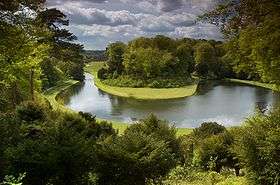 The Park, one feature of the World Heritage Site | |
| Location | North Yorkshire, England |
| Criteria | Cultural: i, iv |
| Reference | 372 |
| Inscription | 1986 (10th session) |
| Coordinates | 54°6′58″N 1°34′23″W |
 Map showing location of Studley Royal Park 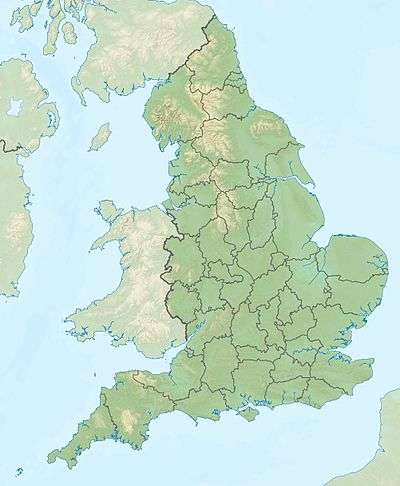 Studley Royal Park (England) | |
History
Fountains Abbey and Hall
Fountains Abbey was founded in 1132 by Benedictine monks who left St Mary's Abbey, York to follow the Cistercian order. After the dissolution of the monasteries in 1539 by Henry VIII, the Abbey buildings and over 500 acres (200 ha) of land were sold by the Crown to Sir Richard Gresham, a merchant. The property was passed down through several generations of Sir Richard's family, then sold to Stephen Proctor who built Fountains Hall probably between 1598 and 1604. The hall is a Jacobean mansion, built partly with stone from the Abbey ruins.[2] Fountains Abbey mill is the only 12th-century Cistercian cornmill left in the UK and the oldest 'intact' building on the estate.
Studley estate
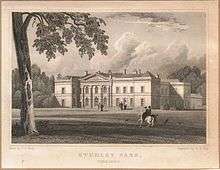
From 1452 onwards, Studley Royal was inhabited by the Mallory family,[3] most notably by MPs John Mallory and William Mallory. John Aislabie inherited the Studley estate from his elder brother in 1693. He was the Tory Member of Parliament for Ripon in 1695, and in 1718 became Chancellor of the Exchequer. Aislabie was a principal sponsor of the South Sea Company scheme, the bill for which was promoted by him personally. In 1720 when this vast financial operation collapsed, he was expelled from Parliament and disqualified for life from public office.
Aislabie returned to Yorkshire and devoted himself to the creation of the garden he had begun in 1718. After his death in 1742, his son William extended his scheme by purchasing the remains of the Abbey and Fountains Hall. He extended the landscaped area in the picturesque romantic style, contrasting with the formality of his father's work. Between them, the two created what is arguably England's most important 18th-century Water Garden.
After William's death, the estate passed to his daughter Elizabeth Allanson and then to her niece, Mrs Elizabeth Sophie Lawrence, who lived there from 1808 until her death in 1845. It then devolved to Thomas de Grey, 2nd Earl de Grey, a distant relative on whose death in 1859 the estate passed to his nephew the Marquess of Ripon, the Viceroy of India, who built St Mary's church in the park. On the death of Frederick Robinson, 2nd Marquess of Ripon in 1923, the estate was acquired by his cousin Clare George Vyner.
In 1966 the estate was bought by West Riding County Council and in 1983 was taken over by the National Trust.
Studley Royal House
.jpg)
Studley Royal House (or Hall) stood in the north-west corner of the park. Originally a medieval manor house, having a main block with forward projecting wings, it burned down in 1716 and was rebuilt by John Aislabie. He filled in the centre, to which his son William added a portico in 1762 to complete its Palladian appearance.
The building was destroyed by fire in 1946. A large stable block, built between 1728 and 1732, survived and is now a private house ( 54° 7'30.55"N 1°34'34.82"W ).
Recent history
In 1966 the estate was purchased by West Riding County Council and was acquired by the National Trust in 1983. The Abbey precinct is managed by English Heritage on behalf of the National Trust. In 1986 the entire Park was designated a World Heritage Site by UNESCO. It gained recognition as it fulfills the criteria of “being a masterpiece of human creative genius, and an outstanding example of a type of building or architectural or technological ensemble or landscape which illustrates significant stages in human history”.
Since 1994 the estate has been within the Nidderdale Area of Outstanding Natural Beauty.
Major features
The park incorporates Fountains Abbey, Fountains Hall, and a number of other notable historic features.
Studley Royal Water Garden
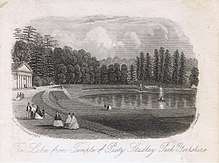
The water garden at Studley Royal created by John Aislabie in 1718 is one of the best surviving examples of a Georgian water garden in England. It was expanded by his son, William who purchased the adjacent Fountains Estate. The garden's elegant ornamental lakes, canals, temples and cascades provide a succession of dramatic eye-catching vistas. It is also studded with a number of follies including a neo-Gothic castle and a palladian-style banqueting house.
St Mary's Church

St Mary's Church was one of two, late Victorian, memorial churches in Yorkshire, built by the family of the First Marquess of Ripon in memory of Frederick Grantham Vyner. The other is the Church of Christ the Consoler at Skelton-on-Ure, and the architect of both was William Burges. Vyner was murdered by Greek bandits in 1870 and his mother, Lady Mary Vyner, and sister, Lady Ripon, used the unspent ransom, gathered to obtain his release, to build two churches in Vyner's memory on their respective Yorkshire estates. Burges' appointment as architect was most likely due to the connection between his greatest patron, John Crichton-Stuart, 3rd Marquess of Bute and Vyner, who had been friends at Oxford. St Mary's, on Lady Ripon's estate at Studley Royal, was commissioned in 1870 and work began in 1871. The church was consecrated in 1878. As at Skelton, Burges' design demonstrates a move from his favoured Early-French, to an English style. Pevsner writes of "a Victorian shrine, a dream of Early English glory." The interior is spectacular, exceeding Skelton in richness and majesty. The stained glass is of particularly high quality. St Mary's is Burges' "ecclesiastical masterpiece."[4]
Deer park
The medieval deer park, where the church stands, is home to between 300 – 350 deer and a wealth of flora and fauna. At Studley there are three types of deer: Red Deer, Fallow Deer and Sika Deer.
Image gallery
.jpg) Main entrance to park
Main entrance to park Stable block, now converted to a private house
Stable block, now converted to a private house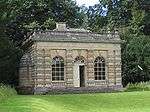 Palladian-style banqueting house
Palladian-style banqueting house Interior of banqueting house
Interior of banqueting house View of the water garden showing the Gothic folly of the Octagonal Tower
View of the water garden showing the Gothic folly of the Octagonal Tower The Chorister's House (located adjacent to St Mary's Church)
The Chorister's House (located adjacent to St Mary's Church)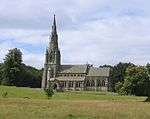 St Mary's Church
St Mary's Church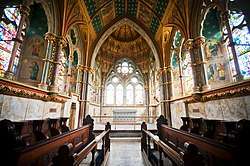 Chancel of St Mary's Church
Chancel of St Mary's Church The Obelisk Above St Mary's Church
The Obelisk Above St Mary's Church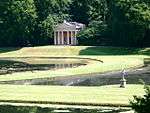 Temple of Piety and water gardens
Temple of Piety and water gardens Octagon Tower
Octagon Tower one of the fishing pavilions and weir
one of the fishing pavilions and weir Temple of Fame
Temple of Fame view across the Water Gardens
view across the Water Gardens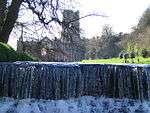 Cascade
Cascade
Notes
- "National Trust Fountains Abbey and Studley Royal Water Garden". National Trust. Retrieved 20 April 2012.
- "Studley Royal Park including the Ruins of Fountains Abbey – UNESCO World Heritage Centre". Retrieved 7 February 2012.
- "MALLORY, JOHN". History of Parliament Online. Retrieved 5 June 2015.
- "History and Research: St Mary's Church, Studley Royal". English Heritage. Retrieved 7 February 2012.
References
- "My turbulent life as an aristocrat" (Web and Print). The Northern Echo. Newsquest Media Group. 28 February 2005. Retrieved 6 June 2018.
- Crook, J. Mordaunt (1981). William Burges and the High Victorian Dream. London: John Murray. p. 454. ISBN 0-7195-3822-X.
Further reading
- Newman, Mark (2015). The Wonder of the North: Fountains Abbey and Studley Royal. Boydell Press in association with the National Trust. ISBN 978-1-84383-883-8.
External links
| Wikimedia Commons has media related to Studley Royal Park. |
